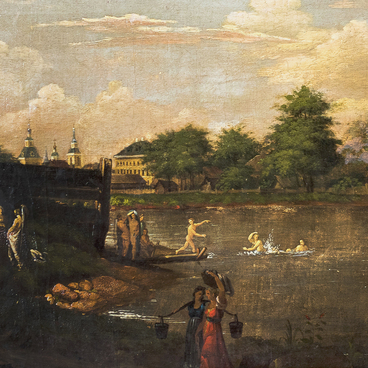During the middle of the Pleistocene, the geological epoch that lasted from about 2,588,000 years ago to 11,700 years ago, Irish elk (Megaloceros giganteus) lived in the open steppe of the modern-day Volsk district. This species is also called the Irish deer or the giant deer.
The Irish elk lived across Eurasia, from Ireland to Lake Baikal. Fossils of this species were found even in North Africa.
The Irish elk is a distant relative of the modern fallow deer, but its size was different. It stood up to 2.1 m tall at the shoulders and weighed from 450 to 700 kg. This extinct hoofed animal had such distinguishing characteristics as concave frontals, a long braincase, and the absence of upper canines.
Based on ancient cave paintings, the Irish elk had light coloration with a dark stripe along its back, a dark collar on the throat, and a chinstrap. Cavemen often depicted the Irish elk with a hump on the withers. Scientists suggest that it might have been used to store fat.
The Irish elk carried antlers that were similar in structure to those of the modern elk and reindeer species. They are considered the largest antlers among the modern and extinct representatives of the family. They had an average weight of 40 kg and a span of over 3.5 m from tip to tip.
Such powerful antlers required a lot of calcium and phosphate. The chemical analysis of the enamel of their teeth showed that the Irish elk fed mainly on plants — various grasses, shrubs, and young shoots.
The Department of Nature of the Volsk Museum of Local History houses a fragment of a giant deer’s antler, found in 1953. It is light brown and has a V-shape with three small tines. The left one has been perfectly preserved, while the two right ones are broken off. One can see that the bone structure is porous on the break, and the surface is rough. There is a vertical split on the preserved tine.
In members of the Cervidae (deer) family, antlers develop from cutis — the connective tissue part of the skin — and are composed of bone. Every year, such antlers are shed and then regrown. When a deer sheds its antlers, special cartilage covered with skin grows on the pedicle — a new pair of antlers later develops from it. Growing antlers are very sensitive, as they are packed with blood vessels and nerves. After ossification, the skin covering the horns bursts and slides back, with traces of blood vessels left on the surface in the form of cavities and roughness.
Megaloceros disappeared during the late Quaternary extinction, which started in the late Pleistocene — 130,000 years ago. At this time, the climate of the planet changed significantly, and Homo sapiens started to spread across the world. The critical factor for the Irish elk was the spreading of the forest into its habitat — the open spaces.
The Irish elk lived across Eurasia, from Ireland to Lake Baikal. Fossils of this species were found even in North Africa.
The Irish elk is a distant relative of the modern fallow deer, but its size was different. It stood up to 2.1 m tall at the shoulders and weighed from 450 to 700 kg. This extinct hoofed animal had such distinguishing characteristics as concave frontals, a long braincase, and the absence of upper canines.
Based on ancient cave paintings, the Irish elk had light coloration with a dark stripe along its back, a dark collar on the throat, and a chinstrap. Cavemen often depicted the Irish elk with a hump on the withers. Scientists suggest that it might have been used to store fat.
The Irish elk carried antlers that were similar in structure to those of the modern elk and reindeer species. They are considered the largest antlers among the modern and extinct representatives of the family. They had an average weight of 40 kg and a span of over 3.5 m from tip to tip.
Such powerful antlers required a lot of calcium and phosphate. The chemical analysis of the enamel of their teeth showed that the Irish elk fed mainly on plants — various grasses, shrubs, and young shoots.
The Department of Nature of the Volsk Museum of Local History houses a fragment of a giant deer’s antler, found in 1953. It is light brown and has a V-shape with three small tines. The left one has been perfectly preserved, while the two right ones are broken off. One can see that the bone structure is porous on the break, and the surface is rough. There is a vertical split on the preserved tine.
In members of the Cervidae (deer) family, antlers develop from cutis — the connective tissue part of the skin — and are composed of bone. Every year, such antlers are shed and then regrown. When a deer sheds its antlers, special cartilage covered with skin grows on the pedicle — a new pair of antlers later develops from it. Growing antlers are very sensitive, as they are packed with blood vessels and nerves. After ossification, the skin covering the horns bursts and slides back, with traces of blood vessels left on the surface in the form of cavities and roughness.
Megaloceros disappeared during the late Quaternary extinction, which started in the late Pleistocene — 130,000 years ago. At this time, the climate of the planet changed significantly, and Homo sapiens started to spread across the world. The critical factor for the Irish elk was the spreading of the forest into its habitat — the open spaces.



